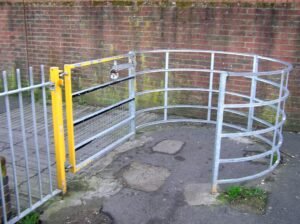Getting rid of barriers
By Andy Chivers
Andy is a trustee of Cyclox
There are many barriers to using a bike – lack of segregated paths, feeling unsafe, having no access to a bike, lack of a safe place to store a bike. The list goes on. But this article is about the physical barriers placed along cycle paths. They are designed to do exactly what is says on the tin – provide a barrier against something. And who are they trying to keep out?
The most common explanation for these barriers is that they are there to prevent unauthorised vehicles from getting onto the cycle path – mainly cars, mopeds and motorbikes. You will usually find barriers where a cycle route meets another path or a road. They often have the added purpose of slowing down cyclists for their own or others’ safety.
Doing more harm than good

As the photos show, Oxford showcases a huge variety of cycle-path barriers. Most of them are designed to let ordinary two-wheeled bikes go through. The one off Girdlestone Road into the Churchill Hospital grounds (main picture) wins the prize – it is even difficult for a regular two-wheeler to get through. The chicane barriers (two or three gates creating a zigzag route) are particularly problematic for trailers or cargo bikes. They are totally no-go for mobility scooters. And we are still seeing barriers being installed inappropriately. The latest example is on the newly-built slip path from the A44 down to the canal just south of Yarnton.
Another example of barriers which do more harm than good are those at staggered crossings on dual carriageways. They are designed to keep walkers and wheelers safe from motor traffic. Instead they create conflict as people pass each other in a small awkward space.
Many of these barriers stop legitimate users accessing cycle paths. They make paths impossible for bikes with trailers, cargo bikes, tagalongs, three-wheelers, hand-propelled bikes or wheelchairs.
What is more they don’t seem to stop the vehicles that they are meant to be keeping out. It is commonplace to see mopeds, motorbikes and illegal doctored e-bikes (a modern scourge) whizzing through barriers.
What are the rules on barriers?

The Department for Transport published the definitive guidance on cycle infrastructure in 2020 – the Cycle Infrastructure Design. This sets out the standards we should all expect for cycling infrastructure. It states that where barriers disadvantage people with disabilities, efforts should be made to remove them or provide an acceptable alternative route. Chicane barriers are singled out for especial criticism because they impede non-standard bikes.
The guidance is clear: many of these different designs of barriers should not be used unless it is unavoidable.
For existing routes, the guidance recommends that barriers should be removed whenever possible. New schemes should ideally have no barriers. Instead, clear separation between pedestrians and cyclists should be the aim.
It goes further, stating that:
- Barriers should only be used to prevent motorbike riders if intermittent police presence doesn’t work.
- Slowing cyclists down should be achieved the same way as slowing motorists – rumble strips or speed humps – but again proportionately and ‘used sparingly’.
- Safety for cyclists and walkers at junctions with the cycle path should be achieved by ensuring good sight lines so that traffic is visible in plenty of time.
What happens if barriers are removed?
Sustrans commissioned some research, reported in May 2023, which found an experimental removal of barriers made cycle routes more accessible and busier. More people means more ‘eyes on the street’ which makes paths safer and deters motor cycles accessing routes illegally.
Cyclox and other cycling and walking groups will be working with Oxfordshire County Council on a barriers policy with the aim of removing the barriers that keep out people on non-standard bikes. This is one more step on the way to removing barriers to cycling.
